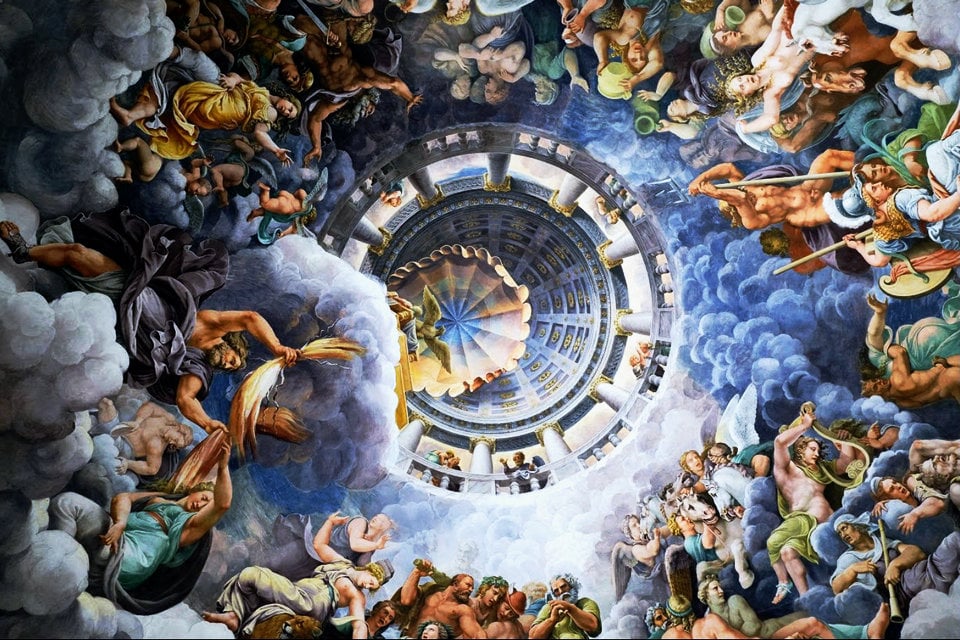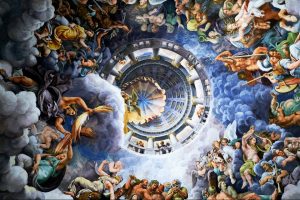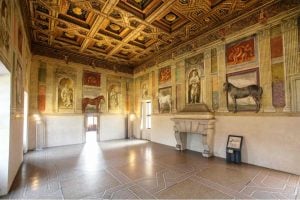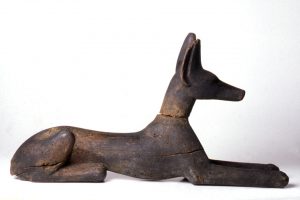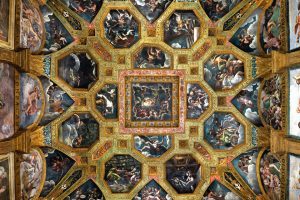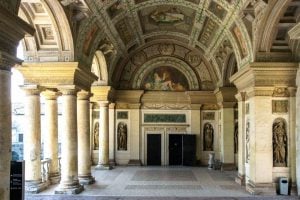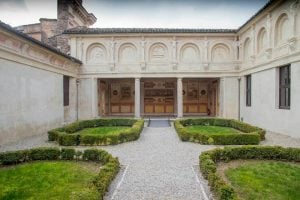Hall of the Giants: the fresco of the Fall of the Giants was painted between 1532 and 1535, covering the room from the walls to the ceiling with the illusionistic representation of the battle between the Giants trying to climb to the Olympus and Zeus. The Sala dei Giganti is one of the most famous frescoed rooms inside Palazzo Te, designed in Mantova by Giulio Romano.
The Empire and the Giants
The second part of virtual tour centres around the painting of the Giants, who are desperately attempting to conquer the mount Olympus. It is an allegory of the pointless rebellion of the enemies of Carlo V and of the Empire. The frescoe creates a particular atmosphere, highlighting the cave-like appearance of the room that is similar to a grotto or an ancient tomb.
A marvellous art work that still today fascinates visitors: the Hall of the Giants, a room made to look like a cave, is decorated with representations of monstrous creatures waging an attack on the Mount Olympus and the heavens. Jupiter is fighting to defend his children. Giulio Romano turned the vault into a sky, with a series of not concentric circles. The perspective reaches a climax, something that was later imitated by many artists, with a canopy under which stands the throne of the king of the gods. Significantly it is empty, although there is an eagle that represents both Jupiter and the empire. The entire representation also has a political meaning, in that it alludes to the triumph of Charles V and the defeat of his enemy. It is interesting to see how the painter, probably Rinaldo Mantovano, creates a chaotic and indistinct crowd of divinities, almost hidden behind the white clouds, frightened by the march of the Giants who are about to fall, hit by lightening.
In a curious but coherent way, the sky ends behind Jupiter’s canopy just as a vault would. The heavens are closed, in a manner that is characteristic of Giulio Romano’s art, that combines an invented reality with an artificial space. The twelve columns, almost hidden by a cloud, support the imaginary part of the cupola and trace another circle, a third one with respect to the one formed by the clouds and the one created by the canopy. The result is a celestial chart, that the Giants intend to destroy.
The Giants, colossal figures painted as hungry peasants intent on lifting the mounts and throwing them against the cupola of the rulers, appear in many places of the painting, being at the same time buried under the rocks they are trying to upturn. The story illustrates mythological episodes taken from Latin literature, but what is important here is the dynamism of the scene, that translates the violence of the rebels into a continuous rotating movement: the Giants are destined to fall into the bowels of the earth.
The architecture of the upturned universe falls onto the rebels, signifying the defeat of irrationality and of blind fury.
History
It was built between 1531 and 1536. It is the main hall of the building. The most outstanding feature of the room is that the painting completely and continuously covers all the available surfaces: a single fresco that places the viewer at the center of the event narrated in the painting. The room has a square base surmounted by a domed ceiling. In the dome is represented Zeus who, with a beam of lightning, defeats the Giants, portrayed starting from the floor while they are trying to ascend to the Olympus.
The episode takes up the myth of the Gigantomachy, the struggle of the Giants against Jupiter, as narrated by Ovid. Compared to the text of Hesiod, where the Giants are described as a sort of thousand-armed monsters, they are represented here as men. Next to the giants are represented monkeys, absent in the text of Ovid. According to Guthmüller these differences must be attributed to the text used by Giulio Romano, which was not the original version but a translation by Niccolò degli Agostini, which had reported an error in the interpretation of the text previously present.
In the painting of Giulio Romano we find the style of the master Raffaello Sanzio but more majestic and imposing and less refined.
According to some, this fresco could refer to the victory of Charles V over Protestants, in memory of the visit the emperor had made to Mantua a short time before.
Palazzo Te
The Palazzo Te is a historic and monumental building in Mantua. a fine example of the mannerist style of architecture, Built between 1524 and 1534 on commission by Federico II Gonzaga, it is the most famous work of the Italian architect Giulio Romano. The complex is now home to the civic museum and, since 1990, the International Center for Art and Culture of Palazzo Te which organizes exhibitions of ancient and modern art and architecture.
